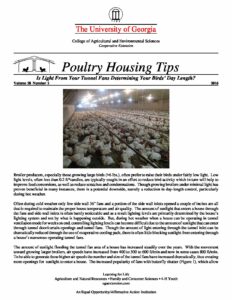Broiler producers, especially those growing large birds (>6 lbs.), often prefer to raise their birds under fairly low light. Low light levels, often less than 0.2 ft*candles, are typically sought in an effort to reduce bird activity which in turn will help to improve feed conversions, as well as reduce scratches and condemnations. Though growing broilers under minimal light has proven beneficial in many instances, there is a potential downside, namely a reduction in day-length control, partic...ularly during hot weather.
Often during cold weather only few side wall 36" fans and a portion of the side wall inlets opened a couple of inches are all that is required to maintain the proper house temperature and air quality. The amount of sunlight that enters a house through the fans and side wall inlets is often barely noticeable and as a result lighting levels are primarily determined by the house’s lighting system and not by what is happening outside. But, during hot weather when a house can be operating in tunnel ventilation mode for weeks on end, controlling lighting levels can become difficult due to the amount of sunlight that can enter through tunnel door/curtain openings and tunnel fans. Though the amount of light entering through the tunnel inlet can be dramatically reduced through the use of evaporative cooling pads, there is often little blocking sunlight from entering through a house’s numerous operating tunnel fans.
The amount of sunlight flooding the tunnel fan area of a house has increased steadily over the years. With the movement toward growing larger broilers, air speeds have increased from 400 to 500 to 600 ft/min and now in some cases 800 ft/min. To be able to generate these higher air speeds the number and size of the tunnel fans have increased dramatically, thus creating more openings for sunlight to enter a house. The increased popularity of fans with butterfly shutter which allow more light into a house compared to traditional tunnel fans with interior shutters has also contributed to the problem. Last but not least is the trend in today’s wider houses where a portion of the tunnel fans are installed in the end wall. When a tunnel fan is located in an end wall sunlight can be projected far along the length of a house. The net result of all these changes is that light intensity in the tunnel fan area of a house can easily exceed 75 ft*candles, which is 300 times brighter than what is typically desired.....
Details
| Year | Volume | Number | Categories |
|---|---|---|---|
| 2016 | 28 | 2 |

